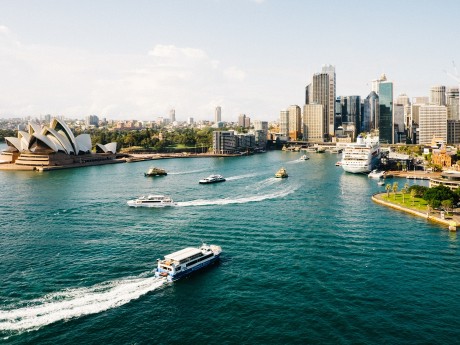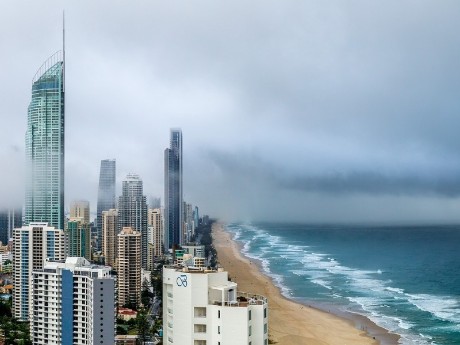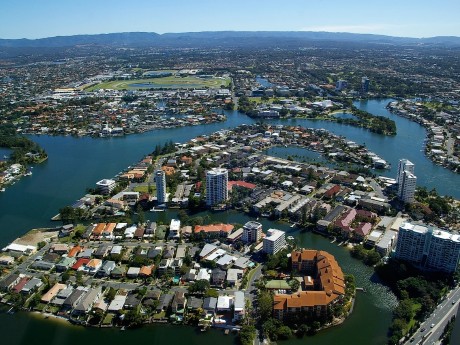Australia: Sydney & Gold Coast
Explore Sydney and the Gold Coast — a duo of spectacular treasures and remarkable experiences on an amazing Australian odyssey. Discover Sydney's renowned Sydney Opera House and the magnificent Harbour Bridge while being surrounded by the city's dynamic energy. Soak up the sun on Bondi Beach or explore the Botanic Garden. Make unforgettable experiences with family and friends by traveling to the Gold Coast, where magnificent beaches and exhilarating theme parks are waiting.
Read more
Explore Sydney and the Gold Coast — a duo of spectacular treasures and remarkable experiences on an amazing Australian odyssey. Discover Sydney's renowned Sydney Opera House and the magnificent Harbour Bridge while being surrounded by the city's dynamic energy. Soak up the sun on Bondi Beach or explore the Botanic Garden. Make unforgettable experiences with family and friends by traveling to the Gold Coast, where magnificent beaches and exhilarating theme parks are waiting. Try a variety of water activities such as jet skiing, parasailing, snorkeling and paddleboarding.This tropical paradise is perfect for nature lovers and explorers alike. This adventure offers an unrivalled fusion of urban allure, coastal charm, and the wonders of nature creating an unforgettable Australian adventure filled with memories to last a lifetime! Waterviews strives to offer accommodation options within walking distance of water and/or in an area of touristic interest. Our prices include taxes (but excludes local tourist taxes). Customize your trip to your personal preferences with optional activities (hit the “Add Activities’’) or change hotels, etc. Contact us for customization at no extra cost at: Service@waterviewstravel.com
Destinations
- Sydney
- Gold Coast
Itinerary
Sydney

Australia’s largest and arguably most popular city immediately conjures up images of the iconic Harbour Bridge and Opera House, yet Sydney has much more to offer. From the green parks and excellent beaches and the nearby Blue Mountains, to its excellent and creative gastronomic scene and interesting cultural attractions, Sydney has something for everyone. Spend a day exploring the history, attractions and culture of the city before exploring some of Australia’s finest nature.
Read more
Australia’s largest and arguably most popular city immediately conjures up images of the iconic Harbour Bridge and Opera House, yet Sydney has much more to offer. From the green parks and excellent beaches and the nearby Blue Mountains, to its excellent and creative gastronomic scene and interesting cultural attractions, Sydney has something for everyone. Spend a day exploring the history, attractions and culture of the city before exploring some of Australia’s finest nature.
Additional Information
History
Sydney is the oldest European settlement in Australia, having been founded as a British penal colony on 26 January 1788 by Arthur Phillip. This day is now celebrated as Australia Day to mark the establishment of a new nation, although also regarded by many as Invasion Day that marked the beginning of the British appropriation of Aboriginal land. The settlement was named "Sydney" after Thomas Townshend, 1st Viscount Sydney, who was the British Home Secretary at that time.
People
Sydney is one of the most cosmopolitan cities on the planet, with one third of its population born overseas. European settlement rapidly displaced the Aboriginal people of the Sydney area with colonists largely coming from England, Ireland and Scotland. The Australian goldrush attracted more immigrants, including a significant number of Chinese, with about one in six Australians with convict descent also having some Chinese ancestry. In the early 20th century, Sydney continued to attract immigrants - mostly from the UK and Ireland, with the White Australia Policy preventing non-European peoples (and even Southern Europeans) from settling. Australia's immigration patterns, and consequently, that of Sydney, changed significantly after World War II, when migrants began to arrive from countries as diverse as Italy, Greece, Germany, the Netherlands, China, New Zealand, India, the Philippines, Poland, Lebanon, Iraq, Vietnam, Thailand, South Africa and the Pacific Islands. Sydney's culture, food and general outlook well reflect these contributions to the majority Anglo-Celtic institutions and social establishment.
Sydney is recognised worldwide for its vibrant LGBT community. Every year, the Sydney Gay and Lesbian Mardi Gras is celebrated on the first weekend in March, drawing people from all over Australia and the world for the celebrations.
Sydney was the centre of the world's attention in September 2000 when the city hosted the Summer Olympics - announced by the IOC Chairman at the closing ceremony to be "the best games ever". The Olympics saw a major building and renovation program take hold of Sydney, positioning it as one of the great world cities of the 21st century.
Climate
|date=July 2017 }} Sydney enjoys over 300 sunny days each year, and it's a year-round destination. Avoid the hottest days for energetic outside activities, and avoid the coolest if you're planning a beach holiday. Summer (December to February) is the best time to enjoy Sydney's beachside outdoor lifestyle. Temperatures usually reach around 26°C (about 79°F) but it can be very hot, particularly further inland and to the west, with temperatures climbing to over 40°C (104°F) for a few days each summer. Summer days can be humid, and sometimes have searing dry winds, but hot days frequently end with a "southerly buster", a cold front sweeping up from the south, bringing a clearly noticeable drop in temperature, as well as rain and thunder. Within hours, the storm can pass and the evening continues cooler. Hot, windy days can create a risk of bushfire, and on days of severe risk national parks and walking trails may be closed. Occasionally low pressure systems drift down from the tropics, giving periods of more unstable weather. You won't need to pack much more than T-shirts to visit Sydney in summer, but remember your hat and sunglasses. Autumn (March to May) is still warm with mild nights. There can be good days for the beach in March, but you can't count on it. It is a good time for visiting attractions, going to the zoo, catching ferries around the harbour without the summer crowds. You may need a warm top for the evenings, especially for May. Winter (June to August) is cool, not cold. Average July maximum temperatures are 17°C, and daytime temperatures rarely drop below 14°C, but night-time temperatures can fall to below 10°C. Most rain falls as a result of a few off-shore low pressure systems, which usually result in two or three rainy weeks during winter. The Bondi Icebergs will be in the ocean doing their morning laps, but most of Sydney will be well away from the beach. It does not snow in Sydney, and unless you intend spending long periods outside, you can usually get by with just a warm top. Sydney is a year-round city, and only the outdoor water-parks close for the winter. If the beach isn't your scene, and you don't like the heat, winter may be your time to visit. Spring (September to November). Spring days are great for exploring Sydney's attractions, bushwalking, cycling, and the outdoors. Beaches are generally patrolled from the end of October, and Sydneysiders start flocking to the beaches in November.
Sydney's Western Suburbs, which lie away from the coast, tend to be hotter during the day, colder during the night and not receiving as much rain. They miss the afternoon sea breezes and the night-time warming effect of the ocean.
Most public buildings like shopping centres are climate controlled inside. Sydney has a fascination with year-round alfresco dining, where you can find yourself dining mid-winter outdoors with a heater a few tables away. Around 90% of public transport has heating and cooling. For the other 10% climate control consists of an open window. Carry water on a hot day.
Sydney climate and weather information is available online at the Australian Bureau of Meteorology.
Architecture
Sydney’s skyline is large and widely recognisable. Sydney also possesses a wide diversity of modern and old architectural styles. They range from the simple Francis Greenway's Georgian buildings to Jorn Utzon’s Expressionist Sydney Opera House. Sydney also has many Victorian buildings, such as the Sydney Town Hall and the Queen Victoria Building. The most architecturally significant structures include the Sydney Opera House and the Sydney Harbour Bridge. Skyscrapers in Sydney are also large and modern. The tallest building is the 300-m-tall Sydney Tower, seen rising clearly above the rest of the Sydney skyline.
There are also pockets of architecturally significant housing dotted around Sydney's suburbs. The inner-eastern suburb of Paddington is known for its terrace houses, while several inner-west suburbs contain streets lined with so-called federation houses (built around the time of Australian federation in 1901). A well preserved example of federation houses in Sydney is in the Inner West suburb of Burwood. Appian Way is a circular street built around a lawn tennis courts complete with pavilion house. The large houses are all architecturally unique and built on large expanses of land featuring old trees and lovely gardens. Further away on the lower North Shore, Castlecrag is a unique suburb, being planned by the architect Walter Burley Griffin in the 1930s.
Itineraries
Walking tour of Sydney - mainly around Central Sydney. Please see separate listing for detailed information. One week in Sydney - some ideas on how to spend a week in and around Sydney, exploring different areas
© Sourced from Wikivoyage
Gold Coast

With endless sandy beaches lined with surfers, a year-round sunny climate and a lively nightlife and cultural scene, Gold Coast is an iconic Australian destination. When relaxing on the beach visitors may feel like they’re in a far away paradise, but on seeing the high rise buildings by the beachfront are reminded of the metropolis itself. Gold Coast boasts sun, fun and surf, and is a must for those looking to experience the fun-loving spirit of the region.
Read more
With endless sandy beaches lined with surfers, a year-round sunny climate and a lively nightlife and cultural scene, Gold Coast is an iconic Australian destination. When relaxing on the beach visitors may feel like they’re in a far away paradise, but on seeing the high rise buildings by the beachfront are reminded of the metropolis itself. Gold Coast boasts sun, fun and surf, and is a must for those looking to experience the fun-loving spirit of the region.
Additional Information
Climate
The climate of the Gold Coast ensures that travellers are able to enjoy the area year round. It has a mild, sub-tropical climate, with an average high of 29°C in January and 21°C in July. The winter months tend to have little rainfall, while the summer has frequent storms originating from the west.
Predictions of rain often equate to brief and intense afternoon storms, rather than extended periods of gentle rain.
Geography
The Gold Coast is a large urban area with a population of 550,000. The Gold Coast shares its infrastructure, facilities, services and labour market with Brisbane to the north. Workers commonly commute between the two by rail and road.
Many tourists believe the highrise buildings and crowds of Surfers Paradise make it an overdeveloped 'tourist trap'. However, most of these buildings are residential ones populated by locals. The city also has many services and industries not directly related to tourism.
The Gold Coast, that visitors are more familiar with, stretches along the coastal suburbs from Paradise Point to Tweed Heads (about 35 km). Surfers Paradise, towards the northern end, is the hub of the leisure activity.
History
Lieutenant James Cook became the first European to chart the region when he sailed along the coast on 16 May 1770. Captain Matthew Flinders, an explorer charting continent north of the colony of New South Wales sailed past in 1802. Escaped convicts from Moreton Boy penal settlement hid in the region. The region remained uninhabited when John Oxley landed at Mermaid Beach, which was named after a cutter named Mermaid.
Commonwealth Games
The XXI Commonwealth Games were held on the Gold Coast between 4 to 15 April 2018. The Commonwealth Games is an international multi-sport event with competitors from around 70 countries.
© Sourced from Wikivoyage





